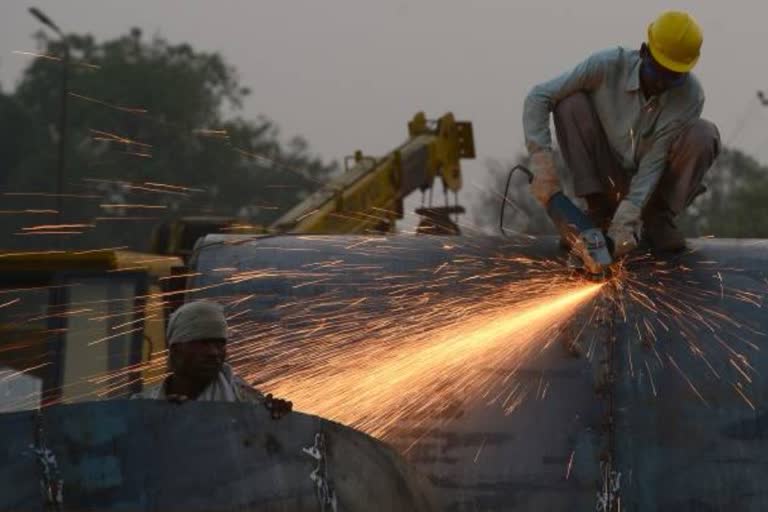New Delhi: Last Friday’s data release showed GDP grew 4.7 per cent in the last quarter. This overturned consensus expectations that the economy would turn the corner in October-December, although the predicted number was correct to the dot.
The deceleration continued because growth in past two quarters was revised up. GDP is now estimated to have grown 5.6% and 5.1% in April-June and July-September respectively instead of 5% and 4.5%.
It’s a puzzle as to why downward revisions to last year’s national income estimates should scale up current year’s quarterly GDP growth as annual growth is still forecast at 5% for 2019-20, which implies that Jan-March growth will be constant at 4.7%.
It is likely that growth estimates will be further revised later.
That economic performance in the last quarter was worse than in July-September, an outstandingly poor quarter that showed up plunging consumer confidence and business sentiments, deep contraction in car sales, corporate performance and much else, is puzzling.
Revised data also shows steady strengthening of private consumption demand in the year 2019-20! At 5.9% in the last quarter, private consumer spending accelerated from a revised 5.6% and 5% in preceding two quarters.
The evolving dynamics of various growth components continues to disappoint. The most notable feature here is that were it not for a 12% growth in government expenditure, GDP would have grown slower at 3.5%!
This perpetuates the pattern of public spending props to growth seen throughout the year 2019-20.
It is clearly unsustainable given the government’s weak fiscal position, besides exposing the continuing deficit of independent growth drivers that are failing to merge.
Read more: Around Rs 10.52 lakh cr of corporate debt at risk of default due to slowdown: Report
The latter is visible in the other demand-side components that faltered miserably the contraction in both imports and investment deepened considerably, primarily reflecting the contractionary trend in manufacturing visible for two successive quarters.
In fact, signs of persisting slowdown are seen in almost all supply side components except agriculture and public administration.
One must flag here the startling collapse in construction, which barely grew; growth rate here has fallen 2.6 percentage points each quarter in this year until now.
As often happens in the past few years, expectations of a recovery will once more be rolled over into the next or current quarter.
However, many analysts have focused on the small sequential uplift in non-agriculture, non-government GDP to spot an upturn last December quarter, the original narrative.
This is true but it is hard to say at this point if this trend will hold and gather strength in the following months or was driven by inventory restocking.
Signs are nebulous and provide insufficient ground for optimism. On the positive side, while industrial production data for January is not yet known, core industries output recorded a 2.2% growth in the month; this represents a turn from the negative growth in August-November 2019.
Then, goods and services tax or GST collections grew 8.03% in February over a year ago (Rs 1.05 trillion).
On the other hand, signs from the financial side, e.g. bank credit growth, which fuels much of the country’s economic engine, are less than encouraging: after an 8.5% growth in January, non-food credit offtake has fallen back to 6.3% in the first fortnight of February 2020.
Then, growth in personal loans was robust in January (41% in consumer durables, followed by credit cards outstanding and housing) but contrary indications come from car sales, which remained insipid in February as manufacturers remained focused on clearing inventory of BS-IV vehicles and consumer confidence still weak.
Finally, February’s Manufacturing Purchasing Managers' Index manufacturing declined nearly one point from January due to weaker demand and production, although still holding firm.
Thus it remains to be seen if the slight uptick is due to re-stocking or something more endurable.
But prospects ahead, at least in the short-term, have suddenly darkened. This is mainly because of the exceptional uncertainties triggered by the Chinese coronavirus shock.
The COVID-19 shock has already led to raw material shortages and disrupted supplies in pharmaceuticals, auto and electronics industries.
It has significantly affected world output growth, whose impact will no doubt pull down Indian export growth too.
The COVID-19 effect currently is expected to persist for at least some months. Future uncertainties surrounding this particular shock are high; this reflected in market reactions worldwide and the ensuing volatility is disruptive for economic activities.
A second drag to growth recovery could be cuts in government spending. This is a typical feature of any government in the last quarter each year, but it is likely to be especially marked this year due to large revenue losses.
The government was recently reported to have asked its departments and ministries to restrict spending to 10% of their 2019-20 budgetary allocations in March, against the 15% limit advised in December, in order to contain fiscal slippage.
Overall, short-term growth and recovery prospects remain quite grim or unoptimistic.
There is some hope held out by RBI’s exceptional easing through unconventional and sector-specific measures. Whether lower interest rates and credit availability are able to manoeuvre a turnaround in an otherwise adverse environment remains to be seen ahead.
(Renu Kohli is a New Delhi based Macroeconomist. Views expressed above are her own.)



